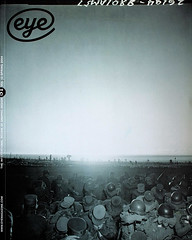Spring 2004
Graphic tourism
Shooting, cropping and editing turns the vernacular into glossy publishing.
A recent batch of books surveys the vernacular streetscapes of Cuba, India, New York, Mexico, Egypt, Tokyo and elsewhere. Loopy cartoons and brutal lettering sell tacos and car batteries, and hand-painted murals display film stars’ images, storeys high. Around the world, urban surfaces chronicle the resourceful endeavours of both established and nameless artists.
In Sensacional!: Mexican Street Graphics, David Byrne writes: ‘We must memorialise the anonymous artists in this book, and in others, because their work is in danger of disappearing.’ This comment follows right after a piece by another writer that denies any anthropological agenda. Even so, the designer ventures into this field as an ethnographer, recording and filtering images of ways of life that are vanishing under the pressures of neo-colonialism.
The alternative position, however, is that of a ‘graphic tourist’ – collecting souvenirs of the exotic while ignoring the imbalance of power between observer and observed …
Jason Grant
Like many Third World countries, Mexico is in the process of being ‘rediscovered’ through a rash of books about its street graphics and imagery. One of the first was Mucho Por Ver (‘A Lot to See’, 2000), which was given away free at the Museum of the City. In this book, in an essay titled ‘The Rabble of the Sun’, critic Conrado Tostado (director of the museum at the time) wrote: ‘One reason for the perplexity facing these graphics is the fact that they seem to ask us a question: “who are you?” That is where the setbacks start. We know what we mean by ‘popular graphics’ … but, what shall we call its opposite, those graphics which are not “popular”?’
Sensacional de Diseño Mexicano followed in 2002. It is essentially a compendium of some of the best rotulista wall paintings found throughout Mexico. Juan Carlos Mena (its co-author, with Óscar Reyes) wrote: ‘This book recognises all of the artists whose inventiveness has moved us but who are largely ignored … With this book we have attempted to take the first step toward the recovery and re-evaluation of what we believe is also our reflection – a genuine living museum that wakes each day to a new image.’ Trilce Editiones, the book’s publisher, is now working on a series of spin-off products: Sensacional note-books, bags – even a slab of embossed chocolate in a stencilled plywood case.
In 2003, the monumental, 1500-page ABC DF: Diccionario Gráfico de la Ciudad de México finally hit the shelves of the luxury bookstores . . .
Daoud Sarhandi
First published in Eye no. 51 vol. 13 2004
Eye is the world’s most beautiful and collectable graphic design journal, published quarterly for professional designers, students and anyone interested in critical, informed writing about graphic design and visual culture. It is available from all good design bookshops and online at the Eye shop, where you can buy subscriptions and single issues.

